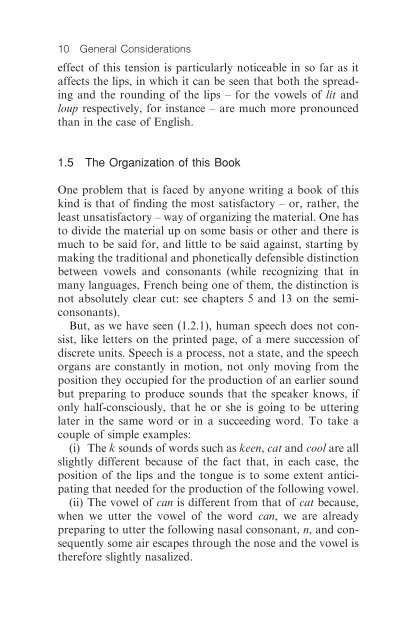An Introduction to French Pronunciation
An Introduction to French Pronunciation
An Introduction to French Pronunciation
You also want an ePaper? Increase the reach of your titles
YUMPU automatically turns print PDFs into web optimized ePapers that Google loves.
10 General Considerations<br />
effect of this tension is particularly noticeable in so far as it<br />
affects the lips, in which it can be seen that both the spreading<br />
and the rounding of the lips – for the vowels of lit and<br />
loup respectively, for instance – are much more pronounced<br />
than in the case of English.<br />
1.5 The Organization of this Book<br />
One problem that is faced by anyone writing a book of this<br />
kind is that of finding the most satisfac<strong>to</strong>ry – or, rather, the<br />
least unsatisfac<strong>to</strong>ry – way of organizing the material. One has<br />
<strong>to</strong> divide the material up on some basis or other and there is<br />
much <strong>to</strong> be said for, and little <strong>to</strong> be said against, starting by<br />
making the traditional and phonetically defensible distinction<br />
between vowels and consonants (while recognizing that in<br />
many languages, <strong>French</strong> being one of them, the distinction is<br />
not absolutely clear cut: see chapters 5 and 13 on the semiconsonants).<br />
But, as we have seen (1.2.1), human speech does not consist,<br />
like letters on the printed page, of a mere succession of<br />
discrete units. Speech is a process, not a state, and the speech<br />
organs are constantly in motion, not only moving from the<br />
position they occupied for the production of an earlier sound<br />
but preparing <strong>to</strong> produce sounds that the speaker knows, if<br />
only half-consciously, that he or she is going <strong>to</strong> be uttering<br />
later in the same word or in a succeeding word. To take a<br />
couple of simple examples:<br />
(i) The k sounds of words such as keen, cat and cool are all<br />
slightly different because of the fact that, in each case, the<br />
position of the lips and the <strong>to</strong>ngue is <strong>to</strong> some extent anticipating<br />
that needed for the production of the following vowel.<br />
(ii) The vowel of can is different from that of cat because,<br />
when we utter the vowel of the word can, we are already<br />
preparing <strong>to</strong> utter the following nasal consonant, n, and consequently<br />
some air escapes through the nose and the vowel is<br />
therefore slightly nasalized.












